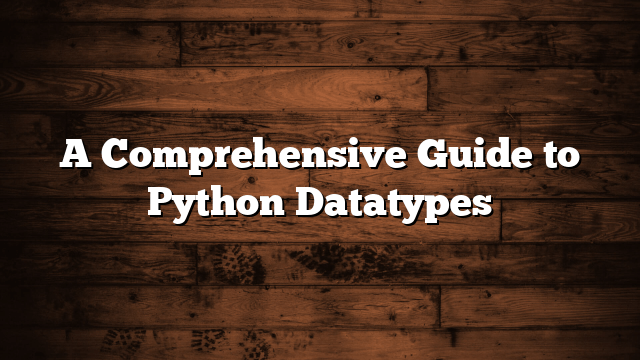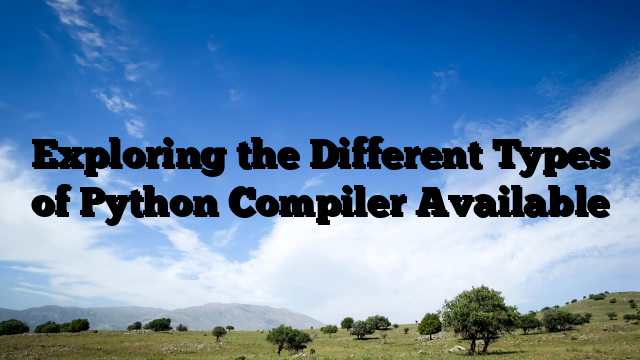- Exploring the Amazing Python Features
- Understanding Memory Management in Python: A Comprehensive Guide
- Exploring the Benefits of Python Programming
- Exploring the Best IDE for Python Programming
- Java or Python: Which Language Holds the Key to Your Programming Success?
- PHP vs Python: Which Language is Best for Your Project?
- From Bugs to Brilliance: Harnessing Python Exceptions for Powerful Coding
- Types of inheritance in python
- How to Create an Android App with Python
- Python vs C++: Uncovering the Best Programming Language for Your Needs
- How should I start learning Python?
- Python Dictionary: A Comprehensive Guide to Understanding and Using Dictionaries
- Introduction to Python Generators: What They Are and How to Use Them
- A Comprehensive Guide to Understanding Python else if Statements for Optimal Decision Making
- Boost Your Programming Skills with Python NumPy: An In-Depth Exploration of Its Features
- Exploring the Different Types of Python Compiler Available
- Understanding Python Tuples: A Comprehensive Guide
- Python List: A Comprehensive Guide to Working with Lists in Python
- Exploring Logical Operators in Python: A Comprehensive Guide
- Exploring the Different Types of Python Operators: A Comprehensive Guide
- A Comprehensive Guide to Python Datatypes
- Introduction to Python for Beginners
- Python Download: Your Comprehensive Guide to Getting Started
- how to comment out multiple lines in python
This comprehensive guide to Python datatypes provides a thorough of the different types of data that can be used in Python programming. From numbers and strings to lists and dictionaries, this guide will help you understand the different types of data available and how to use them effectively. It also provides examples of how to use each type of data in a Python program. With this guide, you’ll be able to create powerful and efficient programs that use the right data types for the job.
Overview of Python Datatypes
Python is a powerful, high-level, object-oriented programming language. It is one of the most popular programming languages in the world and is used for a wide variety of applications. As with any programming language, Python has a variety of data types that can be used to store and manipulate data.
Python has five standard data types: numbers, strings, lists, tuples, and dictionaries. Each of these data types has its own characteristics and uses.
Numbers are the most basic data type in Python. They can be either integers (whole numbers) or floating-point numbers (decimals). Numbers can be used to perform mathematical operations, such as addition, subtraction, multiplication, and division.
Strings are sequences of characters. They can be used to store words, sentences, or any other type of text. Strings can be manipulated using various string methods, such as slicing, concatenation, and formatting.
Lists are sequences of objects, such as numbers, strings, or other lists. They are mutable, meaning that they can be changed. Lists can be used to store and manipulate data in a variety of ways.
Tuples are similar to lists, but they are immutable, meaning that they cannot be changed. Tuples are useful for storing data that should not be changed, such as coordinates or colors.
Dictionaries are collections of key-value pairs. They are used to store data in a more organized way than lists or tuples. Dictionaries are useful for storing data that needs to be accessed quickly, such as user data or configuration settings.
Python also has a few other data types, such as sets and files. However, these are less commonly used than the five standard data types.
Python’s data types are powerful and versatile, and they can be used to store and manipulate data in a variety of ways. Understanding how to use them effectively is an important part of becoming a proficient Python programmer.
Working with Numbers in Python
Python is a powerful programming language that is used for a variety of applications, including working with numbers. Working with numbers in Python involves understanding the different data types available and how to manipulate them.
Python has several built-in data types for working with numbers, including integers, floats, and complex numbers. Integers are whole numbers that can be positive, negative, or zero. Floats are numbers with decimal points and can also be positive, negative, or zero. Complex numbers are numbers that contain both real and imaginary components.
Python also has several built-in functions for working with numbers. These functions allow you to perform mathematical operations such as addition, subtraction, multiplication, and division. Python also has functions for finding the absolute value of a number, calculating the square root of a number, and more.
In addition to the built-in functions, Python also has several modules that can be used to work with numbers. These modules include the math module, which provides functions for working with trigonometric functions, logarithms, and more. The random module provides functions for generating random numbers, and the statistics module provides functions for performing statistical calculations.
Python also has several libraries that can be used to work with numbers. These libraries include NumPy, which provides functions for working with matrices and arrays, and SciPy, which provides functions for performing scientific calculations.
Finally, Python also has several packages that can be used to work with numbers. These packages include pandas, which provides functions for working with data frames, and scikit-learn, which provides functions for performing machine learning algorithms.
Working with numbers in Python is an important skill for any programmer. Understanding the different data types available and how to manipulate them is essential for working with numbers in Python. Additionally, understanding the various built-in functions, modules, libraries, and packages available for working with numbers can help make your code more efficient and powerful.
Strings and Sequences in Python
Python is a versatile programming language that can be used for a variety of tasks. One of the most important aspects of Python is its data types. Python has two basic data types: strings and sequences.
A string is a sequence of characters, such as a word or phrase. Strings are immutable, meaning they cannot be changed once they are created. Strings can be created using single or double quotes, and can be concatenated (combined) using the + operator. Strings can also be indexed, meaning that individual characters can be accessed by their position in the string.
Sequences are a type of data structure that store a collection of elements. The elements in a sequence can be of any type, including strings, numbers, and other sequences. Sequences are also immutable, meaning they cannot be changed once they are created. Sequences can be indexed, meaning that individual elements can be accessed by their position in the sequence.
Python has several built-in sequence types, including lists, tuples, and range objects. Lists are mutable, meaning they can be changed after they are created. Tuples are immutable, meaning they cannot be changed after they are created. Range objects are immutable, and can be used to generate a sequence of numbers.
Python also has several built-in functions for manipulating strings and sequences. These functions can be used to search for substrings, reverse strings, and sort sequences.
In summary, strings and sequences are two of the most important data types in Python. Strings are immutable sequences of characters, while sequences are collections of elements of any type. Python has several built-in sequence types, as well as functions for manipulating strings and sequences.
Working with Dictionaries and Sets in Python
Python is a powerful programming language that is widely used for data analysis and data science. It has a variety of data types, including dictionaries and sets. Dictionaries and sets are two of the most commonly used data types in Python, and they are essential for working with data.
A dictionary is a collection of key-value pairs. Each key is associated with a value, and the key-value pairs are stored in an unordered collection. Dictionaries are useful for storing and accessing data quickly and easily. They are also useful for creating complex data structures.
A set is an unordered collection of unique elements. Sets are useful for storing and accessing data quickly and easily. They are also useful for performing set operations, such as intersection and union.
Both dictionaries and sets are powerful data types in Python. They are essential for working with data, and they are used in many different applications. They are also used in data analysis and data science.
When working with dictionaries and sets in Python, it is important to understand the syntax and the different operations that can be performed on them. It is also important to understand how to access and manipulate the data stored in them.
Dictionaries and sets are powerful data types in Python, and they are essential for working with data. They are used in many different applications, and they are essential for data analysis and data science. Understanding how to work with dictionaries and sets in Python is essential for any data scientist or data analyst.
Advanced Datatypes in Python
Python is a versatile programming language that offers a wide range data types. Advanced data types are an important part of Python, allowing users to store and manipulate complex data structures. Advanced data types in Python include lists, tuples, sets, and dictionaries.
Lists are a type of data structure that can store multiple values in a single variable. Lists are mutable, meaning that they can be changed after they are created. Lists are used to store collections of data, such as strings, numbers, and objects. They are also used to store multiple values in a single variable.
Tuples are similar to lists, but they are immutable, meaning that they cannot be changed after they are created. Tuples are used to store collections of data that will not change, such as a set of coordinates or a list of colors.
Sets are a type of data structure that stores unique values. Sets are used to store collections of data that do not contain any duplicates. Sets are unordered, meaning that the order of the elements in the set does not matter.
Dictionaries are a type of data structure that stores key-value pairs. Dictionaries are used to store collections of data that are associated with each other, such as a list of names and their corresponding phone numbers. Dictionaries are mutable, meaning that they can be changed after they are created.
Advanced data types in Python are an important part of the language, allowing users to store and manipulate complex data structures. Lists, tuples, sets, and dictionaries are all examples of advanced data types in Python. These data types are used to store collections of data that are associated with each other, or collections of data that will not change.
This comprehensive guide to Python datatypes has provided an in-depth overview of the various data types available in Python. From the simple int and float to the more complex tuples, dictionaries, and sets, this guide has outlined the key features of each data type and how they can be used in Python programming. With this knowledge, Python developers can make more informed decisions when selecting data types for their projects. Additionally, this guide has provided useful tips and tricks for working with data types in Python, making it easier to work with data in Python.

















